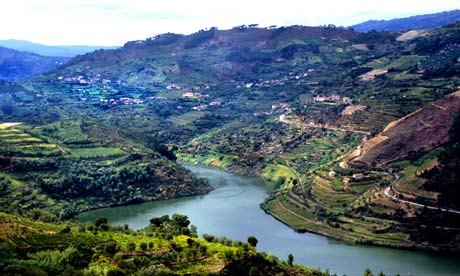
The Douro valley in Portugal is stunning: vertiginous granite slopes, each one divided into rows of narrow terraces topped by vines and supported by dry-stone walls, sweep up from the wide Douro river as it meanders west towards Porto. It's been described as the most beautiful wine region in the world.
Then there's the intriguing social structure. With its mix of tens of thousands of grape growers and a small officer class of wine producers with strong historical links to Britain, the region has, to the outsider, a decidedly Victorian character. Many of the most celebrated producers were founded, and are still run today, by upper-crust expat families including the Symingtons (who produce Cockburn's, Dow's, Graham's and Warre's ports) and the Robertsons (of the Fladgate Partnership behind Taylor's, Fonseca and Croft's ports). Their Portuguese peers tend to share their formal dress codes and manners and both stand in stark contrast to the growers working at their tiny plots.
But while appearances might suggest that this is an inherently conservative place, the Douro has changed. For centuries it had been known only for port, but for the past decade or so it has been arguably the most dynamic table wine region in Europe, helping to establish Portugal as a great producer of top quality dry reds.
If a single individual embodied these changes, it would be the charismatic Dirk Niepoort. Born into a port-producing family of Dutch origin, Niepoort made his first table wine, the massively tannic Robustus, in 1990. The reaction from critics was lukewarm, but Niepoort tried again in a different style with Redoma in 1991, going on to create a range of brilliant wines that made him a cult star.
Niepoort was by no means the first to make decent table wines in the Douro. Barca Velha, the wine with which José Mourinho endeared himself to Sir Alex Ferguson in one of their post-match chats, had its first vintage in 1952. But Niepoort's success was a catalyst, and during the 1990s and 2000s dozens of producers, some established port producers, others new estates, have been moving into table wine.
Though each producer has their own style, Douro reds tend to have perfumed, aromatic dark fruit similar to port, with a craggy, monolithic structure that softens after a few years in bottle to reveal a subtle mineral streak. At their best, the whites tend to be distinctively herbal with tangy acidity and that same minerality.
Not that everyone believes the table wine revolution has been a good thing. With his tongue only slightly in cheek, David Guimaraens of Fonseca port describes the new breed of dry wines as "port for diabetics", and his company has been conspicuous in not moving into table wine. Guimaraens also worries about the sustainability of the shift: local wine regulations mean impoverished growers are guaranteed a fixed price for port grapes that is considerably higher than the unregulated price they can get for table grapes, a price that does not cover the cost of production. In Guimaraens's view, that effectively means port is "subsidising" table wines.
With port sales in long-term decline, however, table wines are going to be increasingly important in the Douro. But the future of this strange and beautiful region rests in producers and growers finding a way for both of these great wine styles to survive.
Six of the best Douro wines
Lavradores de Feitoria Branco 2010 (£8.50, The Wine Society)
The Douro's white wines tend to get overshadowed by the reds, but they can be beguiling. This one, which is made by a co-op of 15 producers with winemaking overseen by Dirk Niepoort, is alive with the joys of spring: a squeeze of citrus and some rich rounded apple fruit.
Quinta do Crasto Douro 2009 (£9.99, or £8.49 if you buy two bottles, Majestic; £8.99, or £8.09 as part of a case of 12 bottles, Adnams)
This fine old producer does a brilliant job of making Douro wines and ports at accessible prices, both in supermarket own-label wines and in this boldly fruit-driven red. The tannins are considerably softer than your average Douro red, making it a good alternative for Aussie shiraz.
Waitrose Douro Valley Reserva Quinta da Rosa 2009 (£10.69, Waitrose or £10.15 at waitrosewine.com)
The best of the supermarket own-label Douro wines, this is made by Quinta de la Rosa, and it has all the trademark elegance and floral aromatics the producer is renowned for. There's plenty of guts and flesh here, too: a piece of red meat is required to soak up the tannins.
Niepoort Drink Me Douro 2009 (£10.95, Uncorked)
Much of Dirk Niepoort's prolific output is designed to age for years and is sold for high prices (although they're no more expensive than many French wines half as good). This one, however, is very accessibly made and priced: with explosive red and black fruits, it's supple, succulent and moreish.
Quinta do Noval Cedro do Noval Vinho Regional Duriense 2007 (£15.50, The Wine Society, ; £18.35, Berry Bros & Rudd)
One of the finest port houses, Noval was a relatively recent convert to table wine, but the move has been entirely successful. Unusually for the Douro, there's a little bit of syrah in here which adds a bit of peppery spice and sinew to a meaty, powerful red.
Quinta do Vale Meão Douro 2009 (£59.95, Handfords)
Expensive it may be, but this is simply stunning wine, comparable in quality to the very best in the world. It's an uncanny mix of the elegant and the powerful with aromatic, violet lift, very pure red and black fruit and mineral depths. One to keep for a few years yet.

